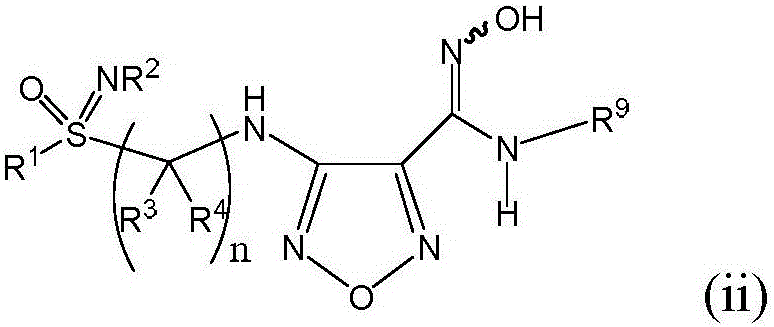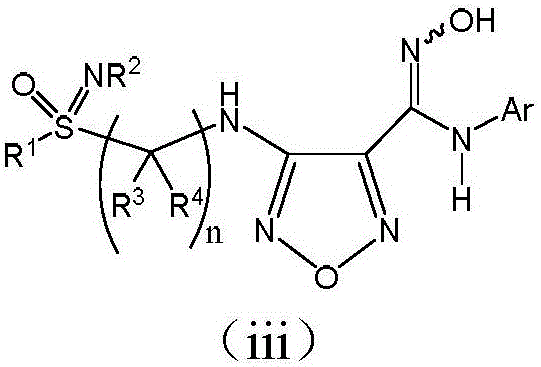Indoleamine-2,3-dioxygenase inhibitor containing sulfoximine subjected to nitrogen alkylation and arylation
A technology of alkyl and aryl, applied in the field of medicinal chemistry
- Summary
- Abstract
- Description
- Claims
- Application Information
AI Technical Summary
Problems solved by technology
Method used
Image
Examples
Embodiment 1
[0252] (±)(Z)-nitrogen-(3-bromo-4-fluorophenyl)-nitrogen'-hydroxy-4-((2-(nitrogen, sulfur-dimethylsulfoximine)ethyl)amino) -1,2,5-oxadiazole-3-carboxamidine
[0253]
[0254] The first step: 4-Amino-nitrogen’-hydroxy-1,2,5-oxadiazole-3-carboxamidine
[0255]
[0256] Dissolve malondicyanide (3.2g, 48.5mmol) in 70mL of water and heat to completely dissolve. Under ice-water bath cooling, sodium nitrite (3.8 g, 55 mmol) and 6N hydrochloric acid (0.6 mL) were added. After reacting in an ice bath for 0.5 hours, the temperature was raised to room temperature and reacted for 2 hours. The reaction solution was continued to be cooled in an ice bath, and a 50% hydroxylamine hydrochloride aqueous solution (9.9 g, 150 mmol) was added dropwise to the reaction solution. After stirring for half an hour, it was raised to room temperature and reacted for 1 hour. The reaction was heated under reflux for 2 hours. After the reaction was completed, the pH was adjusted to 7.0 with 8 mL of 6N hydrochl...
Embodiment 2
[0301] (±)(Z)-nitrogen-(3-bromo-4-fluorophenyl)-nitrogen'-hydroxy-4-((3-(sulfur-methyl-nitroethylsulfoximine)ethyl)amino )-1,2,5-oxadiazole-3-carboxamidine
[0302]
[0303] According to the preparation method of Example 1, the reagent of the tenth step was replaced with triethyloxonium tetrafluoroborate, and the conditions of the eleventh step were used to obtain the target compound.
[0304] 1 H NMR: (400MHz, acetone-d 6 ): δ10.85(s,1H), 8.12(s,1H), 7.28-7.26(m,1H), 7.17-7.13(m,1H), 7.02-6.98(m,1H), 6.64(s,1H) ), 3.81 (s, 2H), 3.57 (s, 1H), 3.43-3.40 (m, 1H), 3.31-3.06 (m, 5H), 1.11-1.05 (m, 3H).
[0305] MS(ESI):[M+H] + m / z=449.0
Embodiment 3
[0307] (±)(Z)-nitrogen-(3-bromo-4-fluorophenyl)-nitrogen'-hydroxy-4-(2-(sulfur-methyl-nitrogen-phenylsulfoximine)ethyl)amino )-1,2,5-oxadiazole-3-carboxamidine
[0308]
[0309] The first step: (±)4-(3-bromo-4-fluorophenyl)3-4-(((2-(methylsulfoxidephenylimine)ethyl)tert-butoxycarbonylamino)-1 ,2,5-oxadiazol-3-yl)-1,2,4-oxadiazolone
[0310]
[0311] The product of the ninth step of Example 1 (20mg, 0.037mmol) was dissolved in dichloromethane (2ml), phenylboronic acid (8mg, 0.055mmol) was added, and copper acetate (5mg) was stirred at room temperature for 2 hours. TLC showed that the reaction was complete. Add water (10ml) and ethyl acetate (10mL) to the reaction solution, then extract with ethyl acetate (2x10mL) and combine the organic phases, then wash with water (10mL), saturated brine (10mL), and dry with sodium sulfate. After concentration, column chromatography is separated and purified to obtain the target compound (15mg, 66% yield)
[0312] 1 HNMR(400MHz, acetone-d 6 ): δ 7...
PUM
| Property | Measurement | Unit |
|---|---|---|
| molecular weight | aaaaa | aaaaa |
Abstract
Description
Claims
Application Information
 Login to View More
Login to View More - R&D
- Intellectual Property
- Life Sciences
- Materials
- Tech Scout
- Unparalleled Data Quality
- Higher Quality Content
- 60% Fewer Hallucinations
Browse by: Latest US Patents, China's latest patents, Technical Efficacy Thesaurus, Application Domain, Technology Topic, Popular Technical Reports.
© 2025 PatSnap. All rights reserved.Legal|Privacy policy|Modern Slavery Act Transparency Statement|Sitemap|About US| Contact US: help@patsnap.com



